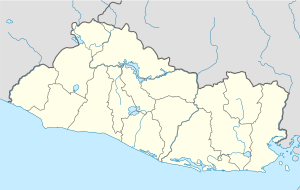San Miguel, El Salvador
| San Miguel | |||
|---|---|---|---|
| City | |||

San Miguel, El Salvador
|
|||
|
|||
| Location in El Salvador | |||
| Coordinates: 13°28′53″N 88°10′39″W / 13.48139°N 88.17750°W | |||
| Country |
|
||
| Department | San Miguel Department | ||
| Founded | 1530 | ||
| Government | |||
| • Mayor | Miguel Perreira | ||
| Area | |||
| • Total | 593.98 km2 (229.34 sq mi) | ||
| Elevation | 129 m (423 ft) | ||
| Population (2012) | |||
| • Total | 183,733 | ||
| • Density | 310/km2 (800/sq mi) | ||
| Website | Official website (Spanish) | ||
San Miguel is a city in eastern El Salvador. It is the country's third most populous city after San Salvador and Santa Ana. It is located 138 km east of the capital, San Salvador. It is also the capital of the department of San Miguel and a municipality. The population of the city in 2007 was 218,410.
Luis de Moscoso Alvarado established the village of San Miguel de la Frontera (Saint Michael of the Frontier) on May 8, 1530, as a bastion for the conquest of the Lenca kingdom of Chaparrastique (Place of Beautiful Orchids). By 1586 the village had obtained the title of city.
In 1655, a volcanic eruption almost totally destroyed the city. According to legend, the devastation was so severe that only an image of Satan in the parish church was spared.
The city has been an important center of the agriculture, textile and chemical industries of El Salvador. Since the early 21st century, the services sector, specially health care and commerce, have increased considerably, resulting in significant private investments in hospitals and shopping malls within the city. This has usually been attributed partly to the high inflow of remittances (at least 35% of the total, which represents around 18% of the national GDP ) that Salvadorans living abroad send to families in the eastern zone of the country.
The incomes and wealth of the eastern half of the country are expected to increase following new jobs and businesses associated with the development of the Puerto La Unión; it started operations in 2012.
There are many educational institutions within the city, private and public, including some of the oldests schools in the country. The main universities are the public University of El Salvador ( with its Facultad Multidiciplinaria de Oriente) and the private Universidad de Oriente (UNIVO).The University Gerardo Barrios, the University Modular Abierta.
The sports infrastructure of San Miguel has had a significant development and modernization since the beginning of the past decade. The main sports centers are the national football stadium of "Juan Francisco Barraza", the "Polideportivo Don Bosco" and the Charlaix Stadium.
...
Wikipedia



